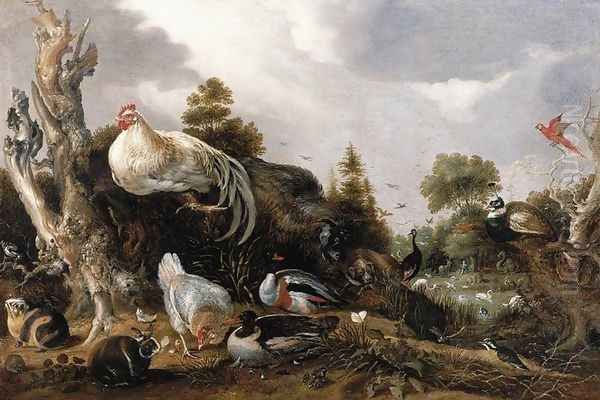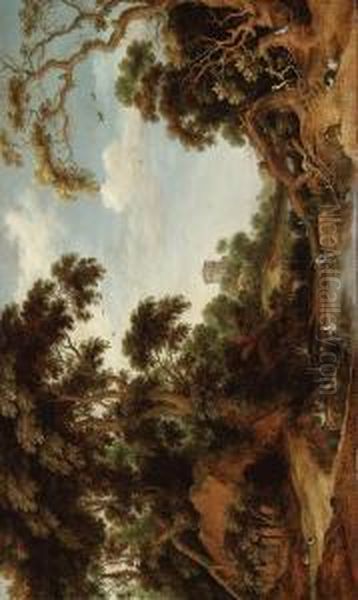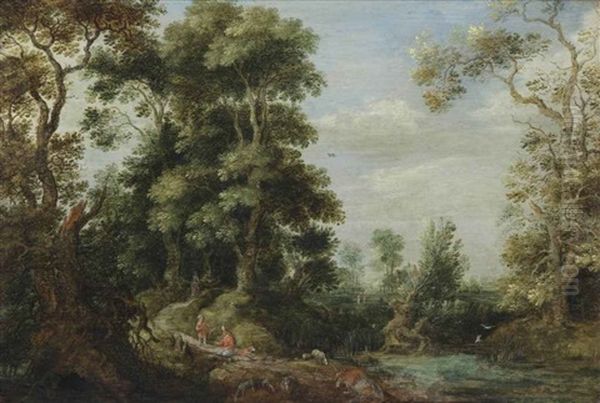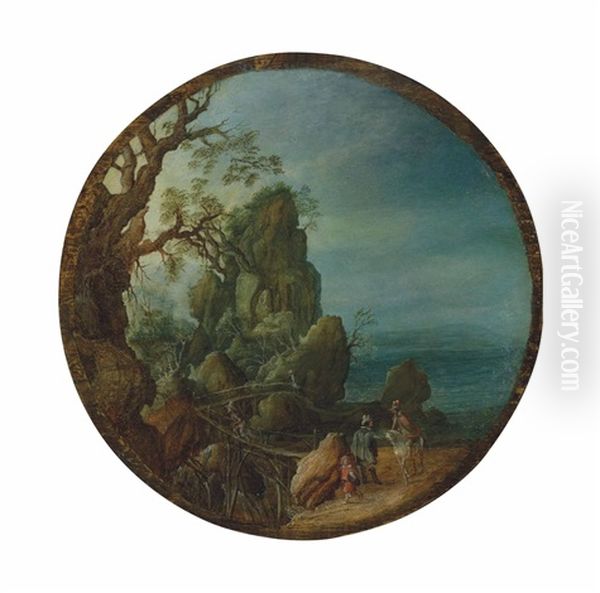
Gillis Claesz. de Hondecoeter stands as a significant figure in the transition of landscape and animal painting during the Dutch Golden Age. Born into the rich artistic traditions of Flanders, he became an influential artist in his adopted home in the Northern Netherlands. Active primarily in the first half of the 17th century, Hondecoeter specialized in creating evocative landscapes, often populated with a diverse array of birds and animals, skillfully blending Flemish narrative traditions with the burgeoning Dutch sensitivity to nature and light. His work not only reflects the artistic currents of his time but also laid the foundation for a remarkable family dynasty of painters, most notably his celebrated grandson, Melchior de Hondecoeter.
Flemish Origins and Migration North
Gillis Claesz. de Hondecoeter was born around 1575 in Mechelen, a city in the Southern Netherlands (now Belgium) known for its vibrant artistic culture. He hailed from an artistic family; his father was the painter Nicolaes Jansz. de Hondecoeter. Growing up in Flanders during a period of political and religious turmoil, particularly the conflicts surrounding the Dutch Revolt against Spanish rule, likely influenced his family's decision to move north. Like many Protestant artists and craftsmen seeking refuge and opportunity, the Hondecoeters eventually emigrated to the more tolerant Dutch Republic.
This migration was a common pattern in the late 16th and early 17th centuries. Artists fleeing the Southern Netherlands brought with them the established Flemish artistic conventions, including a taste for detailed realism, vibrant colours, and often complex, narrative compositions. Gillis de Hondecoeter carried this heritage with him, and it formed the bedrock upon which his artistic identity would be built. His early life and training, though not extensively documented, would undoubtedly have been steeped in this Flemish milieu.
Establishing a Career in the Dutch Republic

By the early 17th century, Gillis Claesz. de Hondecoeter had established himself in the Dutch Republic. Records indicate his presence first in Delft, where he married Maaijke Gijsbrechts in 1602. Delft was already becoming a centre for art and innovation. Later, he moved to Utrecht, another major artistic hub, where he seems to have spent a significant portion of his career before eventually settling in Amsterdam, where he died in 1638. He remarried in Amsterdam in 1628 to Anna Spierinx, suggesting a continued presence in the city's artistic circles.
His presence in Utrecht is particularly noteworthy. During the early 17th century, Utrecht was home to influential artists like Abraham Bloemaert and the Utrecht Caravaggisti (such as Gerard van Honthorst and Hendrick ter Brugghen), although Hondecoeter's style remained more closely aligned with landscape traditions. It was in these Dutch cities that Hondecoeter fully developed his artistic practice, likely joining local Guilds of Saint Luke, which regulated the work of painters and craftsmen. He adapted his Flemish training to the tastes and artistic developments of the Northern Netherlands.
Artistic Style and Development
Gillis de Hondecoeter's artistic style is characterized by its roots in the Flemish landscape tradition, particularly the type of woodland and fantasy scenes popularized by artists like Gillis van Coninxloo III. Coninxloo, another Flemish émigré who worked in Amsterdam, was renowned for his densely wooded landscapes with intricate foliage and a sense of depth created through layers of receding planes. Hondecoeter adopted this compositional structure, often depicting forests with towering trees, detailed undergrowth, and glimpses of distant vistas.
A significant influence on Hondecoeter's work was Roelant Savery. Savery, also of Flemish origin and active in both Utrecht and Amsterdam (as well as Prague), was celebrated for his highly detailed paintings of animals, often exotic species, set within lush, sometimes fantastical landscapes, frequently incorporating rocky mountains inspired by his travels. Hondecoeter clearly absorbed Savery's meticulous approach to rendering animals and his penchant for creating atmospheric, slightly idealized natural settings. Some sources suggest Hondecoeter may have studied with Savery, or at the very least, worked in close proximity, sharing thematic interests.

While his early works retain a strong Flemish character, often featuring biblical or mythological narratives integrated into the landscape, Hondecoeter's style gradually evolved. It absorbed elements more typical of Dutch landscape painting, such as a greater emphasis on atmospheric effects, more naturalistic light, and perhaps a less overtly fantastical approach compared to Savery's most exotic compositions. He developed a particular skill in depicting the textures of bark, leaves, feathers, and fur, bringing his natural subjects to life. There is also evidence suggesting a possible, perhaps earlier, connection or apprenticeship with the painter David Vinckboons, another Flemish artist active in Amsterdam known for landscapes and genre scenes.
Themes and Subject Matter
Landscapes formed the core of Gillis de Hondecoeter's oeuvre. He favoured wooded scenes, often featuring streams or ponds, which provided ideal settings for the birds and animals that became his hallmark. These were not always topographically accurate depictions of specific Dutch locations but rather composed, sometimes idealized, visions of nature. They often followed the established compositional formula of a darker foreground leading the eye through mid-ground planes towards a lighter, more distant background, creating a sense of depth and enclosure.
Animals, particularly birds, were central to his work. Unlike the later specialization of his grandson Melchior, Gillis often included a wider variety of fauna. His paintings frequently feature domestic fowl like chickens, ducks, and geese, often depicted near farm buildings or water edges within the landscape. He also painted waterfowl and occasionally more exotic birds, reflecting the growing interest in the natural world and collections of curiosities during the Dutch Golden Age. Mammals such as deer, goats, and cattle also appear in his landscapes, contributing to the pastoral or sometimes wild atmosphere.
A recurring theme in Hondecoeter's work, especially earlier in his career, was the integration of religious or mythological subjects within the landscape setting. These narratives often provided a pretext for depicting abundant animal life. His painting Orpheus Charming the Animals is a prime example. This subject, drawn from Ovid's Metamorphoses, shows the mythical poet Orpheus playing his lyre, his music so enchanting that wild and tame beasts gather peacefully around him. This theme allowed Hondecoeter to showcase his skill in rendering a diverse menagerie within a harmonious natural world, blending classical mythology with his detailed observation of animals. Other works might depict biblical scenes like the Garden of Eden or Noah's Ark, similarly providing opportunities to populate the canvas with creatures.
Representative Works

Among Gillis Claesz. de Hondecoeter's most characteristic and recognized works is Orpheus Charming the Animals (various versions exist, e.g., in the Rijksmuseum, Amsterdam). These paintings exemplify his ability to merge landscape, mythology, and detailed animal depiction. The composition typically features Orpheus seated beneath trees, lyre in hand, surrounded by an attentive audience of birds and mammals, both familiar and exotic. The lush, wooded setting, rendered with attention to foliage and light filtering through the trees, is characteristic of his style influenced by Coninxloo and Savery. The animals are depicted with care, showcasing his observational skills.
Another work often cited is Animal Landscape. While this title might apply to several paintings, it generally refers to his landscapes where the focus is clearly on the animals inhabiting the scene, even without a specific narrative overlay like the Orpheus myth. These works highlight his specialization and demonstrate the transition from landscapes with animals to landscapes about animals, paving the way for the dedicated animal painting genre that would flourish later in the century. His works often feature a careful balance between the detailed rendering of the fauna and the atmospheric depiction of their natural habitat.
His paintings of poultry yards or birds near water also represent an important aspect of his output. These scenes, perhaps less dramatic than the mythological subjects, allowed for close observation of domestic birds, capturing their characteristic postures and plumage. These works directly anticipate the specialization of his son Gijsbert and grandson Melchior. Examples can be found in various museum collections, showcasing his consistent interest in avian subjects within naturalistic settings.
The Hondecoeter Artistic Dynasty
Gillis Claesz. de Hondecoeter was the patriarch of a significant family of artists who specialized primarily in animal and landscape painting for three generations. His father, Nicolaes Jansz. de Hondecoeter, established the family's artistic path. Gillis successfully continued this tradition, achieving recognition in his own right and passing his skills and thematic interests onto the next generation.
His son, Gijsbert de Hondecoeter (c. 1604–1653), followed closely in his father's footsteps. Gijsbert also specialized in landscapes populated with birds, particularly poultry and waterfowl. His style is often very similar to his father's later works, sometimes making attribution difficult. Gijsbert continued the family workshop and further cemented the Hondecoeter name's association with bird painting.

The most famous member of the dynasty was Gillis's grandson, Melchior de Hondecoeter (c. 1636–1695). Trained initially by his father Gijsbert, and after Gijsbert's death, by his uncle Jan Baptist Weenix (who had married Gillis's daughter Josina), Melchior became the preeminent painter of birds in the later Dutch Golden Age. Often dubbed the "Raphael of bird painters," Melchior took the family specialty to new heights. He focused almost exclusively on birds, both domestic and exotic, often depicting them in dramatic, dynamic compositions set against park-like landscapes or architectural backgrounds. His technical virtuosity, vibrant colours, and ability to capture the character and movement of birds earned him immense fame and patronage. While Gillis laid the groundwork with his detailed animal depictions within broader landscapes, Melchior isolated and elevated the animal subject itself.
The connection to Jan Baptist Weenix (1621–c. 1660) is also significant. Weenix was a versatile painter known for Italianate landscapes, portraits, and still lifes, including game pieces. His marriage into the Hondecoeter family and his role as Melchior's teacher further enriched the artistic environment surrounding the dynasty, potentially introducing different stylistic influences.
Contemporaries and Artistic Milieu
Gillis Claesz. de Hondecoeter worked during a vibrant period in Dutch art history. His career spanned the time when landscape painting was rapidly evolving from the structured, often imaginary scenes of the Flemish tradition towards the more naturalistic and atmospheric depictions characteristic of the Dutch school. He interacted with and was influenced by key figures bridging this transition.
Roelant Savery remains the most prominent connection, sharing Flemish roots, time in Utrecht, and a deep interest in animal depiction within landscapes. Gillis van Coninxloo III represents the earlier Flemish woodland tradition that shaped Hondecoeter's compositions. David Vinckboons, if indeed a teacher or influence, connects him to another strand of Flemish émigré art in Amsterdam, known for lively figure-staffed landscapes and genre elements. The influence of printmakers like Claes Jansz. Visscher, whose landscape prints circulated widely, may also have played a role in disseminating compositional ideas.
In Utrecht, he would have been aware of the broader artistic scene, including the dominant figure of Abraham Bloemaert, whose studio trained many artists and whose own work encompassed landscapes and pastoral scenes. While Hondecoeter's style differs significantly from the Utrecht Caravaggisti, their presence contributed to the city's dynamic artistic climate.
Later landscape painters like Esaias van de Velde and Jan van Goyen were developing a more distinctly Dutch approach, focusing on tonal harmonies and realistic depictions of the local countryside around the same time Hondecoeter was active. While Hondecoeter retained more Flemish elements, he was part of this broader shift towards naturalism. His specialization in animals also prefigures the work of later Dutch animal painters like Paulus Potter, although Potter focused more on cattle within realistic Dutch pastures.
Influence and Legacy
Gillis Claesz. de Hondecoeter's primary influence was undoubtedly on his own family, particularly his grandson Melchior. By establishing a strong tradition of detailed animal painting within landscape settings, he provided the foundation upon which Melchior built his spectacular career. Gillis's focus on birds, his meticulous rendering techniques, and his ability to integrate fauna naturally into their environment were all elements refined and amplified by his descendants.
Through the immense popularity of Melchior de Hondecoeter's work, Gillis's legacy extended indirectly to later European art. Melchior's paintings were highly sought after by collectors across Europe, including royalty and aristocracy. His dramatic compositions and lifelike birds significantly influenced 18th-century French animal painters, notably Jean-Baptiste Oudry and perhaps François Desportes, who specialized in hunting scenes, animals, and decorative compositions for royal residences. Artists like Pierre-Nicolas Huillot also worked in this tradition. The Hondecoeter style, originating with Gillis's blend of Flemish detail and Dutch observation, thus found echoes in French Rococo decorative painting.
More broadly, Gillis de Hondecoeter represents an important link between the Flemish landscape tradition of the late 16th century and the specialized genres of the Dutch Golden Age. He successfully navigated the transition, adapting his inherited style to new environments and tastes while carving out a niche in animal and landscape painting. His works remain appreciated for their detailed execution, charming subject matter, and historical significance as precursors to the more famous animal paintings of the later 17th century. His paintings are held in major museum collections worldwide, including the Rijksmuseum in Amsterdam, confirming his enduring status as a noteworthy artist of the Dutch Golden Age.
Conclusion
Gillis Claesz. de Hondecoeter was more than just the founder of an artistic dynasty; he was a skilled and adaptable painter in his own right. Emerging from the artistic crucible of late 16th-century Flanders, he successfully transplanted his talents to the burgeoning Dutch Republic. His synthesis of Flemish compositional structures, meticulous detail inherited from artists like Roelant Savery, and an increasing sensitivity to Dutch naturalism created a distinctive style. His landscapes, alive with carefully observed birds and animals, and sometimes enriched with mythological narratives like the story of Orpheus, capture a specific moment in the evolution of Dutch art. While perhaps overshadowed in fame by his grandson Melchior, Gillis's contribution to landscape and animal painting, and his role in establishing a family legacy devoted to these themes, secure his place as a respected master of the Dutch Golden Age. His work continues to engage viewers with its intricate detail and evocative portrayal of the natural world.